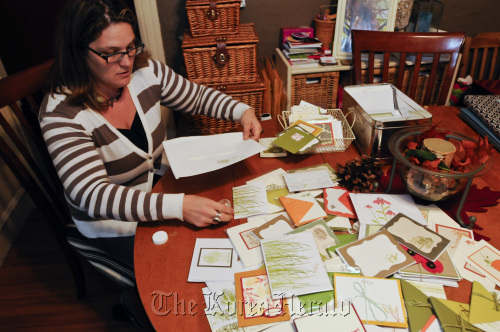PHILADELPHIA ― Most families have a kid who loves to draw.
In the Morris family in rural Pottstown, Pennsylvania, that was Pam. When she wasn’t “playing in the dirt and streams,” she was making little thank-you notes, hand-lettered place cards for holiday dinners, party invitations and birthday greetings.
At 36, she’s Pam Olshefski now, Brian’s wife and the mother of three girls, 8, 6, and 4. You might argue that as part-time curatorial assistant at Morris Arboretum in Philadelphia’s Chestnut Hill (no relation to that Morris), she’s still “playing in the dirt and streams.” She’s definitely still making original cards, combining her appreciation for nature with a long-standing affinity for crafts.
“It’s not a chore,” she says, of those uncommon little notes.
Seriously, who writes personal notes anymore?
Facebook and e-mail, even Twitter, the world’s most trivial telegraph, are layered with thank-yous and happy-birthdays and sorry-for-your-losses. The thoughts may be heartfelt, but they’re expressed so easily and often, their impact is questionable.
There’s no question where Olshefski stands.
A user of Facebook and e-mail ― Twitter? No, no, no ― she believes a handwritten note to mark an occasion or express a thought connects us to friends, family, and community in a deeper, more sustaining way.
“And aren’t those connections and relationships the point of everything?” she asks.
Here’s how it works: “When I sit down and write a thoughtful note, it means I took the time to select a note I thought you would really like. It’s about the other person, not about me.
“And the note itself becomes something endearing. People say, ‘Where did you get that?’” Olshefski says, “I just think it’s a big thing.”
It’s huge for Daniel Post Senning, but you might expect that: He’s the great-great-grandson of Emily Post, sometimes referred to as “the first lady of etiquette,” who wrote the first edition of her influential manners book in 1922.
 |
Pamela Olshefski makes greeting cards at her dining room table, Oct. 26, in Pottstown, Pennsylvania. (Philadelphia Inquirer/MCT) |
Senning, website manager at the Emily Post Institute in Burlington, Vermont, is also coauthor with three other great- and great-great-grands (Peggy, Anna, and Lizzie) of the 18th edition of “Emily Post’s Etiquette,” which came out on Oct. 18.
“I personally feel the medium, the choice you make about the medium to deliver your message, says a great deal,” Senning muses. “Really, taking that extra time to handwrite a thank-you note or develop your own stationery is a statement.”
Which is: “I’m willing to spend the time to invest in building this relationship. Ultimately, you’re talking about a communication strategy going beyond the customary standard,” he says.
One of Olshefski’s specialties is nature-themed cards, reflective of a childhood spent roaming the farm country near her family’s home in northern Chester County, Pennsylvania. “When you went for a walk around the block, it was three miles,” she jokes.
Always a crafts person, Olshefski has been a potter, a seamstress, a maker of jewelry, soap and candles. For the last five years, her cluttered dining room has doubled as a card-making workshop.
There, Olshefski takes rubber or acrylic stamps of leaves, pumpkins, ornamental grasses, flowers, garlic, and trees, dabs them on an ink pad, and prints them on recycled or designer paper bought in bulk.
She sprinkles them with embossing powder and applies a hot embossing gun, which looks like a hair dryer and melts the powder onto the wet ink. This raises the texture of the stamp and gives the note a tactile quality that Olshefski the artiste adores.
“It’s not rocket science but it looks really awesome,” she says.
Sometimes she uses phonebook-pressed leaves, flowers and seeds collected from her garden, a 10-by-18-foot patch of exuberance in front of her century-old twin.
“I love when things jumble and mix all over the place. I know I have a lot of plants,” Olshefski says, without a trace of gardener guilt.
The garden is robust now with milkweed for monarch butterflies, dwarf oakleaf hydrangea, papyrus, amsonia, baptisia, smokebush, hellebores and coneflowers, with a few unusual vines wedged in, such as purple hyacinth bean and the still-feisty yellow and orange Mina lobata, or Spanish flag vine, which sprawls with abandon on one side of the porch.
Senning loves the idea of nature-inspired cards. Based on his experience doing etiquette programs in corporate settings, he also thinks formal, handwritten thank-you notes are making a comeback ― especially among job-seekers and others in business looking to distinguish themselves.
“It’s a really effective way to build your professional image, especially if the note card has your initials or name embossed or stamped on it. It’s very classy,” he says.
By Virginia A. Smith
(The Philadelphia Inquirer)
(MCT Information Services)








